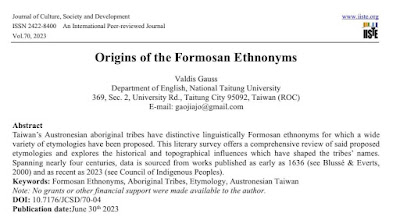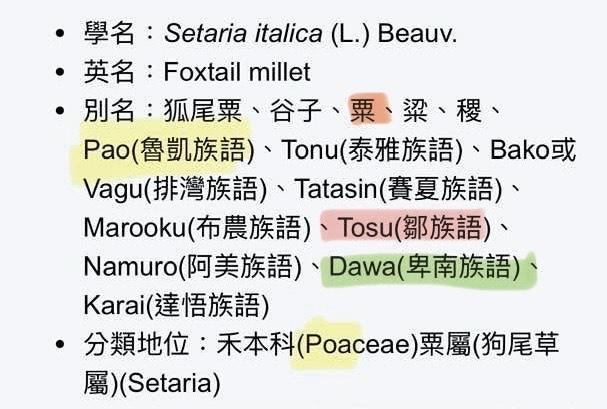Anthropology Observation I (Notes 1-51)
 |
| Puebla -Parian Mexico (Nov 2024) There is a Parian (aka Chinese village) in Keelung - Fuzhou 福州 street. |
Pa-ka Causative Verb “A Consensus” ? Probably not yet.
Something does not seem right, in my opinion, and maybe not right for 30 years.
Proto-Austronesian
linguists need to provide evidence before claiming Pazeh-Kaxabu Pa-ka causative
prefix ‘a consensus’.
Plus
earlier claim of Puyuma/Rukai.(Blust 1999)
Causative MAKE/MADE
Paka - ka-
Proto-Austronesian Linguists need to provide linguist evidence that proto-Austronesian paka- ka- bears no relation with Mandarin Chinese 把給 to make their claim stand.
pa- (Make/Made) only works in Mandarin/Chinese. As far as I see.
Example:
You made my clothes wet.
1. You pa- 把 my clothes ka- 給wet. (Only works in Mandarin)
2. You ka- 給 my clothes wet. (Works in both Mandarin and Hokkien)
3. Pa 把 used in this CONTEXT is equivalent to ka將.
Therefore - in Mandarin/Chinese The
following two sentences grammatically is the same.
You ka-將 my clothes
ka- 給 wet.
You pa- 把 my
clothes ka- 給 wet.
No.2
Pazeh-Kaxabu dialectal distinctions
“Ferrell (1968) was the first to mention
dialectal distinctions between Pazeh and Kaxabu, while Blust (1999b, p. 323)…”
In
my opinion - Blust Rice and Peanut analysis is outdated and flawed.
Proto-Austronesian linguists need to re-examine the (in my opinion outdated) data and analysis before taking (developing) Pazeh-Kaxabu distinction
claims further.
No.3
Shibi/RaiSnay 石壁 Re’nai 瑞岩 (Atayal)
Shibi 石壁 Fujian bills itself as the ‘Cradle of the Hakkas’ for its place in Hakka history.
Shibi/RaiSnay 石壁 Taiwan I have been twice - heavily Hakka influenced area.
nay,nai - loanword from 岩 meaning ROCK. Re,Rai is 瑞。
RaiSnay and Re’nai effectively is the same word just in different phonetic
arrangement/linguistic disguise.
Both meaning Rock.
Both are Fujian place-name known for Rock and Hakka presence.
No.4
Saisiyat and Puyuma (Tsou/Bunun?)
Full-blooded Hokkien Chinese becoming
Legendary Indigenous Leaders
1. Saisiyat 日阿拐
(origin Hokkien 張)1840-1903
2. Puyuma 馬智禮(
origin Hokkien 朱來盛) 1887-1966
3. A mentioned Tsou/Bunun in 17 century yet to
be identified and confirmed.
No.5
Atayal 'Yu' - hot springs
Origin - Japanese Yu ゆ 湯
U’lay/Wulai Predominant Atayal town name CLEARLY isn’t anything of Atayal language.
I am surprised no indigenous linguists
pointed this out YEARS ago and put it right for good.
The key word is 湯 is pronounced Yu ゆ .
No. 6
Hakka Influence Black/Blue
Red
Imported fabric since early 1900s
(Amis, Paiwan/Rukai, Atayal/Saisiyat)
One of the most important information
learned from NTU Anthropology Professor is Indigenous costume colours.
Google you see indigenous develop their own
story and version about their group colours—-
I listened attentively- Professor Lin says
:
1. Amis earlier times Black (and Blue) was
Hakka influences.
2. Paiwan/Bunun/Rikai Black (and Blue)
consequently was Amis influence.
3. Red fabric colour all across Taiwan was
Imported. (In large quantity).
QUESTION: I am curious about Amis word for paper mulberry which makes Amis traditional bark clothes - why did they not have their own vocabulary for this important tradition- but appears borrowed from Taiwanese Hokkien unique Lok-Ah meaning Deer Tree 鹿仔樹. Documented in Qing . WHY?
No. 7
Short-statured mystical people
Saisiyat, Atayal (Seediq and the rest)
You ask this question-“How come a mythical short people who lived
with Saisiyat and Atayal at the same location Ta’ai 大隘
ended up with two complete different names?”
Ta’ai
- Saisiyat named after the place Ta’ai 大隘。Presented a
unique Saisiyat cultural identity.
Ta’ai 大隘 is 1835 Hakka establishment
(Note- Be aware of 洪敏麟 (1999:231) report in this regards ‘ta’ai’ place name and ‘ta’ai’
people.)
Sungut-
Atayal (along with related groups and other more distant groups ) named after
(Japanese-introduced) pigeon peas.
Sungut
is loan word from Chinese 樹豆。
Saisiyat
Northern Ta’ay- ta’ay 大隘 A Beipu Hakka establishment founded in 1835.
Extended to refer to Saisiyat unique
cultural identity- ta’ay 達隘 the short mystical peoples
once lived with Saisiyat at Ta’ay 大隘Wufeng county
Hsinchu.
Southern Tungho 東河
- incidentally one of the 26+ matching Fujian place names I identified.
paSta’ay - pa to perform. A ceremony performed to remember ta’ay 達隘 - Held in each location different hosts North and South currently every 2 years.
No.8
Bunun 豆 taw/pu/bu
pulse beans peas
Bunun 豆 pulse
vocabulary several developed from loan words. Pigeon peas for example from
Latin.
Hyacinth beans from Hokkien 肉 ba.
Many Bunun traditional 豆 (fully detailed including science names, cultivation, ROTATING crops , harvesting on Japanese records) originated from South/Central America.
Mexico where I’ve just been.
No. 9
Saisiyat 祭 sai さい 祭屋 Saiya さいゃ
Saisiyat’s traditional Saiya 祭屋 さいゃis located in Ta’ai 大隘。Wufeng township Hsinchu.
The house is used to remember ta’ay 達隘 the mystical short people who lived in Ta’ai 大隘 with Saisiyat and Atayal.
(ps Atayal call these little people Sungut (pigeon peas) small as peas)
祭屋 Saiya さいやis a Japanese ceremonial term and usage. Always comes with making mochi.
First photo at Shimane Japan - a Grand Sai 祭 where you see 祭屋 Saiya and people making mochi.
No.10
Zaitun 刺桐 - Plains indigenous ‘Calendar’ signifying the beginning of the year.
In particular- The Kavalans (who influenced Amis)
Full details HERE. (https://katyhuiwenhung.blogspot.com/2023/08/zaitun-arabic-olive-indigenous.html)
No. 11
Tsou Aiyu-Jelly
Ficus awkeotsangMAKINO @Alishan
How did Aiyu become Indigenous (in particular with Tsou)?
I
sussed it out with Tsou elder - they don’t eat that stuff, never did.
Aiyu
seeds feed squirrels, squirrels feed Millet Goddess. Aiyu harvesting means squirrels hunting.
Japanese discovered the higher altitude the better Aiyu , therefore it became Indigenous Tsou’s.
No.12
Cajanus cajan /Pigeon peas/ 樹豆
Clearly - Bunun and Tsou (and several others ) from Latin either cajanus or cajan.
Atayal related groups from Chinese 樹豆。(the first time I saw this Sungut ‘spelling’ was from a 15 years old
menu at an indigenous restaurant)
No. 13
#Proto-Austronesian (PAN)
 Is *Cumay* not *Kuma* Japanese for bear? クマ Kuma=bear
Is *Cumay* not *Kuma* Japanese for bear? クマ Kuma=bear Is ‘Rem’ 鯉 lí ?
Is ‘Rem’ 鯉 lí ?  Is sep Hokkien ‘stip’?
Is sep Hokkien ‘stip’? Is ‘cun cun’ Hokkien ts’ian? 嗆 ts’ian
Is ‘cun cun’ Hokkien ts’ian? 嗆 ts’ian  Is it related to Hokkien 熟 si̍k? Cooked .
Is it related to Hokkien 熟 si̍k? Cooked . No. 21
No. 22
Sorghum Bunun word is Latin.
No. 32
No. 38
Saisiyat names
Inconsistent on their parts maybe - based on what they published.
No. 39
No. 40




















































.jpeg)





















































Comments
Post a Comment